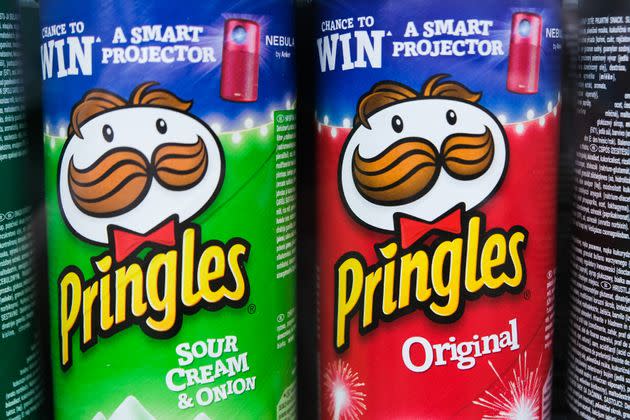I Just Realised What 'Pringles' Actually Stands For, And It's Way More Complicated Than I Thought

We’ve written before at HuffPost UK about why Smarties are called what they are and the meaning behind ‘Hobnob’ and ‘Twix’
But what about the savoury side of the snack industry?
Pringles, invented in 1986 by Proctor & Gamble, was sold to Kellogg’s in 2012.
It was originally sold as “Newfangled Potato Chips” (yes, really).
But how did it get its name?
There are a few theories
Proctor & Gamble have never confirmed where the name comes from, but one theory goes that “two Procter advertising employees lived on Pringle Drive in Cincinnati and the name paired well with potato” (per The New York Times).
Another possible explanation is that Mark Pringle, the co-creator of a potato-processing machine, inspired the name.
The patent described a machine that would create “food product in wafer form of such uniformity in size, weight and shape that can be economically packaged in a very compact manner so as to exclude any appreciable quantity of air.”
It sounds pretty familiar ― but Pringles’ official site says the machine credited for making Pringles was invented by Gene Wolfe, who went on to write sci-fi books.
Wolfe “also bears a striking resemblance to Julius Pringles [the moustached guy on the front of the can],” the site reads.
Yet another theory, from a 1969 article about Proctor & Gamble and Goliath General Foods accidentally naming a product the same thing (Pringles), suggests P&G chose the name “out of a hat.”
Pringles flopped at first
The product, which doesn’t technically count as crisps, was “dead” decades ago, Charles Jarvie, vice president of Procter’s food division in the ’70s, told The New York Times.
The same article says that it wasn’t until the ’80s that the product really took off, thanks to flavour tweaks and a new ad campaign. But “by the late 1990s, Pringles had become a $1 billion a year brand.”
Co-creator of the Pringle Fredric Baur did an impressive job of forming the classic Pringle shape (a hyperbolic paraboloid), Pringles’ site says, but it took Alexander Liepa, the eventual holder of the Pringles patent, to add a tasty enough flavour to the product.
But in case you think the snacks weren’t always beloved by some, think again ― Frederic Baur was so proud of the iconic cylindrical packaging that he literally got buried in a Pringles can.

 Yahoo News
Yahoo News